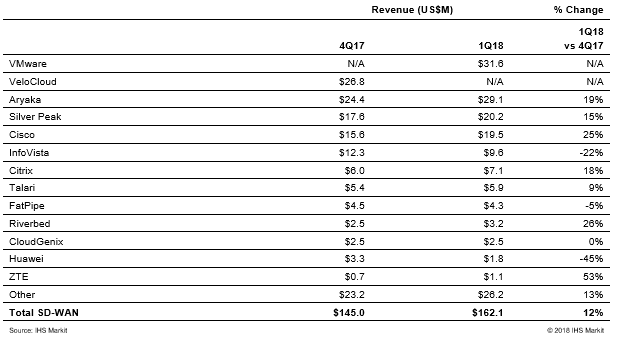The company explains why it thinks deep-packet inspection sets it apart.

**Editor’s Note: Read our list of 20 top SD-WAN providers offering products and services via channel partners.**
If I asked you to name the five biggest software-defined wide area networking (SD-WAN) vendors in the world, who would come to mind?
Likely VMware’s VeloCloud and Cisco. Perhaps Aryaka and Silver Peak as we discussed last week. But would you think of InfoVista?
IHS Markit listed the French company as fifth in its SD-WAN revenue rankings for the first quarter of 2018. A year ago, InfoVista trailed Talari, Citrix and TELoIP, but it grew from $4.4 million in revenue to $12.3 million in 2017, according to the study. It remains locked in a battle with Citrix and Talari for the fifth spot. The vendor has stayed active this year, announcing partnerships and integrations with companies like ZTE, Huawei and Nuage Networks

Source: IHS Markit
We spoke to Andy Asava, InfoVista’s senior vice president of sales for the Americas, to learn how the company sets itself apart. Asava tells us his company focuses on three main categories of solution and products: service assurance built into the heart of carrier networks; testing and measurement of mobility products; and “application-aware” SD-WAN.

InfoVista’s Andy Asava
The journey into SD-WAN began in 2015 when InfoVista acquired Ipanema Technologies, a French company that described itself as a WAN optimization provider at the time
“You can say that Ipanema was the first true pioneer when it came to SD-WAN,” Asava said. “They were providing SD-WAN before that was the terminology that was adopted in the marketplace. But that’s why we have such a massive footprint when it comes to SD-WAN solutions.”
Following the completed integration, InfoVista offers SD-WAN through its Ipanema product line. Asava says one of the original goals was to look at the WAN edge of enterprises and provide deep-packet inspection (DPI). Meantime, it would take a hybrid approach to connectivity.
“Regardless of what kind of interconnect it is – whether it’s all MPLS, whether it’s hybrid, whether it’s internet – we want to make sure that the application experience is always the same,” he said.
InfoVista uses DPI to ensure application consistency on the dynamic WAN. That differs differs from two of the more traditional approaches vendors use, according to Asava: marking a TOS bit or using the 5-tuple criteria.
“We have a DPI engine that enables us to get a deeper sense of what the packet flow needs to be and packet flow requirement needs to be, and we will do the WAN selection based on that,” Asava said. “While our competitors are still on the TOS page, we are already two generations ahead of them because of our DPI capability.”
This type of inspection can also be session-based. Take Office 365 for example. It’s a single application, but it contains a variety of packets and payloads.
“There’s voice and there’s video; there’s IM and email. And each one has a different tolerance requirement from a performance perspective. So we have an ability not just doing the markings and DPI on an application level, but we can do it on a per-session level,” he said.
Asava says his company’s solution is …
… fully virtualized, which gives customers hardware flexibility. Using a single virtual network function allows for different deployment models and doesn’t require a separate box for visibility for the WAN edge.
“We are not a monolithic solution [where] you have to buy the hardware and the software and everything from us,” Asava said. “We are a virtual network function, and we can sit on any UCPE device that’s out there in the marketplace.”
InfoVista sells 100 percent through partners, according to Asava.
Fortinet Leans In
The security vendor has already been embedding its offering into other companies’ SD-WAN platforms, but its new FortiGate Next-Generation Firewall offers its own SD-WAN.
The company said it updated its operating system to make security a “native component.” It’s a response to customers who have expressed concern about using SD-WAN vendors that partner for security.
John Maddison, senior vice president of products and solutions, says application consumption models are migrating to the cloud at a fast clip.
“As our customers move toward direct internet access, they understand the growing need for next-generation firewall capabilities and high SSL inspection performance. To make sure customers realize the benefits of SD-WAN without compromising security, Fortinet has evolved our advanced SD-WAN features in the latest FortiOS releases,” Maddison said. “This focus on secure SD-WAN is clearly resonating with the hundreds of customers and partners who are taking advantage of Fortinet’s unique combination of next-generation firewall and SD-WAN in the same offering, managed through a single centralized controller.”
Read Fortinet’s full announcement.
Cato
Cato Networks announced what it calls the “first identity-aware routing engine for SD-WAN.”
The Cato Cloud now builds policies based on identity and group affiliation.
“Identity awareness adds business context to our end-to-end, converged and secure MPLS alternative, making it easier and simpler for IT to align with today’s dynamic business requirements and deliver an optimal user experience, everywhere,” CEO and co-founder Shlomo Kramer said.
Cato made other enhancements to its offering, including high-availability deployment and real-time network analytics.
Read Cato’s full announcement.
Quick Hits
Nokia’s Nuage Networks, which partnered with InfoVista in February, is now working with Globe Telecom to offer SD-WAN in the Philippines. Read the company’s announcement.
Our sister site, Light Reading, interviewed Aryaka’s chief marketing officer about the company’s offerings. Watch the video.
Windstream partnered with VeloCloud to connect customers to cloud applications. Check out the announcement and look for a bfreakdown from us later today.
Read more about:
AgentsAbout the Author(s)
You May Also Like


